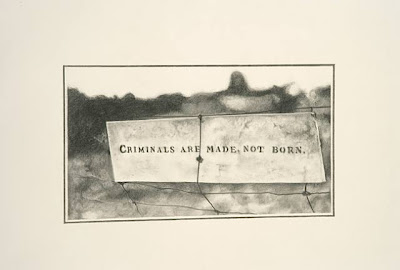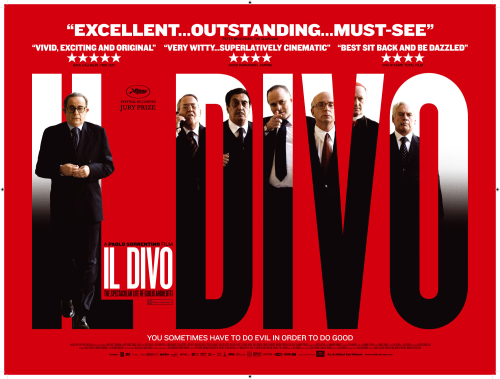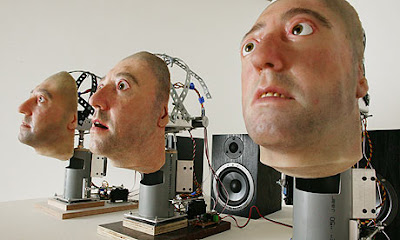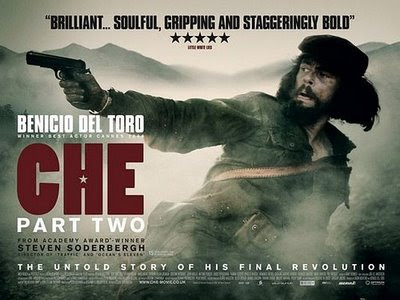

Nicolas Winding Refn, seems to constantly be battling the same criticism leveled at Kubrics 'A Clockwork Orange', namely the glorifying of violence. And while that argument is strictly untrue, the films relationship to Kubrics similarly stylised look at criminality is close in many other ways.
While loosely termed as a biopic, the film is a lot more deep seated than a portrayal of ones character. It is in many ways the opposite to what I have discussed in the 'Che' biopics, there the films aim was to deconstruct myth into a more tangible sense of human character and emotion, with all the follies and contradictions that came with it, shot in an unfussy and realist manner. Here, however, the opposite could be said, as Refn has described; 'it's not so much a biopic, more about a person transforming himself. He is a person who physically morphed himself into becoming 'Charles Bronson'. So in contrast to 'Che', 'Bronson' puts forward a character physically constructing himself into a mythical being, and the film is shot accordingly. Borrowing heavily from Kubric in terms of the use of sound and moving image, the portrayal of extreme acts of violence and hysteria juxtaposed to operatic music, sets in line these obvious connotations to the fictitious playing of a character and the theatricality that this process involves. Also the narrative device of having the Bronson character on a theatre stage in front of an audience to narrate at certain moments continues this theme of filming the fictitious, symbolic and almost metaphysical incarnations of Bronson's world, suddenly something more akin to formal cinema. Although we Bronson giving his life account it is only when in prison or on his stage that the transformation begins. It is a prison drama about a character who doesn't want to leave and will never reform, something we realise from the beginning, something that we won't fully understand, just something we must just run with. Refn has confirmed this futile point when discussing the portrayal of Bronson and the films aims, 'In the original material the writers were trying to psychoanalyse him, but if you do that you actually degrade him, because he's too intelligent, too sophisticated ... He's an extremely intelligent conceptual artist who found his stage, and for some reason it was in the form of solitary confinement. In my movie he's an artist searching for a stage on which to create his performance'. To this end, we see his character flaws (not only in extreme acts of violence), in his lack of proaction, as described in the film by a prison governor, 'Godless and nihilistic acts of aggression'. We hit a complex point in the film as it becomes apparent the aims of Bronson's violence was not to suit any positive end to further himself, but is borne out of pure frustration at his lack of being able to express himself. In the end the use of violence can be seen as a way to portray his character to the world, trying to gain fame this way. Again as Refn describes 'the film is also about the consequences of fame: once you achieve something you will lose something' in this way he achieved infamy but lost freedom and any other possible hope or ambition in his life.
One crucial scene for me is during his brief hiatus outside of prison in which he returns home to his mother only to discover all his possessions from his earlier life are no longer present, reflecting the fact that his old identity is forever lost due to the process of change the prison life has given him and his new alter-ego.
The films structure is set out in a fragmented narrative, between actual (possibly existential) narration and the films recounted narrative. Beginning with the character introducing himself in a close up to camera, from which point we get his life story recounted by him interposed with direct statements from the character himself from his more than symbolic stage. The stylisation of the film, aside from the overt era defining soundtrack, is the culmination of certain recurring shots in the film, dead-pan portraits of full-length figures in front of a flat background in a sort of no-time before a scene of on coming violence as they just watch Bronson before his rage. Also a panning shot following characters movement up and down a space from a side angle offering a mid-shot side profile and overtly referring to the fourth wall behind the camera, that of a theatre audience in a Brechtian manner.
The film is incredibly subversive and intelligent in many ways, although losing at times due to the overplay of swearing in order for laughs, the formal almost modernist touches really highlight the films concepts and unground any possible notion of violence being used in a glorifying way, especially when you consider Bronson never uses it to gain anything, constantly ending up as a beaten pulp at the end of each 'performance'. These performances don't glorify the act they just highlight the futility of it all, and that of Bronson's existence.
Finally as Refn describes his intentions for the films reading ' I thought, what if we turn it on its head? it is much more fascinating to his life like a carnival, because Charles Bronson is not a gangster or a criminal or anything like that... We just have to observe and accept him'.







 Many great era of cinema usually come from countries which are suffering or have recently suffered social or political turmoil. Anybody with even a fleeting interest in european politics would know of the current political climate in Italy. And now subsequently, Italian cinema is seeing something of an upturn.
Many great era of cinema usually come from countries which are suffering or have recently suffered social or political turmoil. Anybody with even a fleeting interest in european politics would know of the current political climate in Italy. And now subsequently, Italian cinema is seeing something of an upturn.











